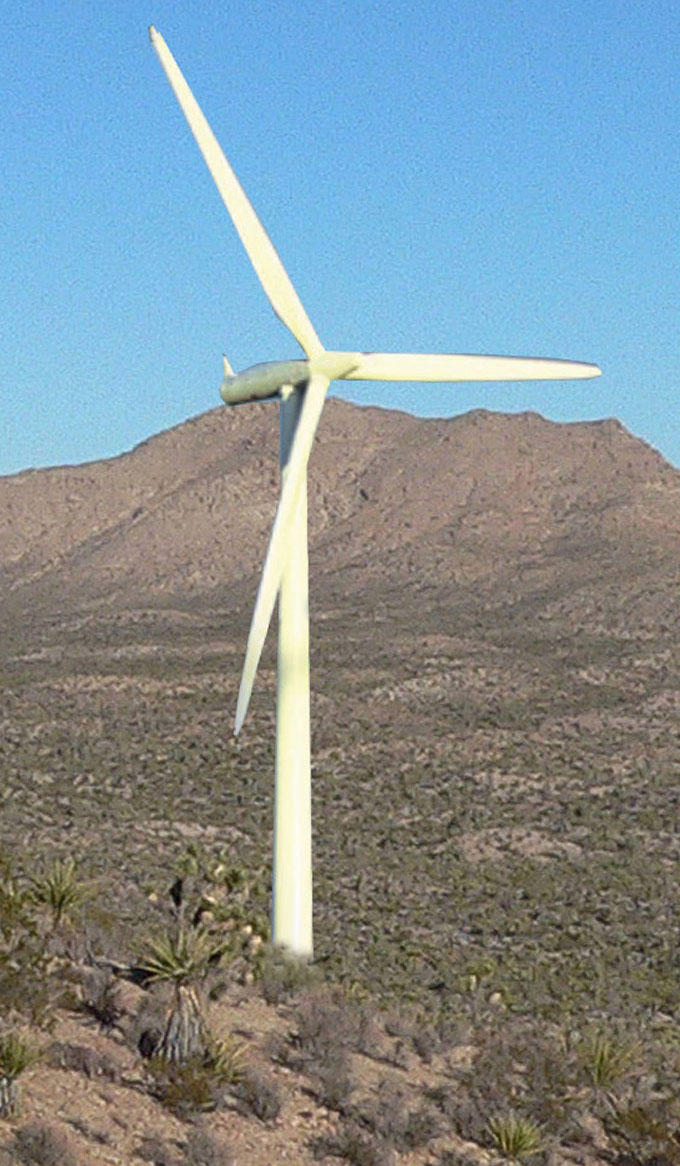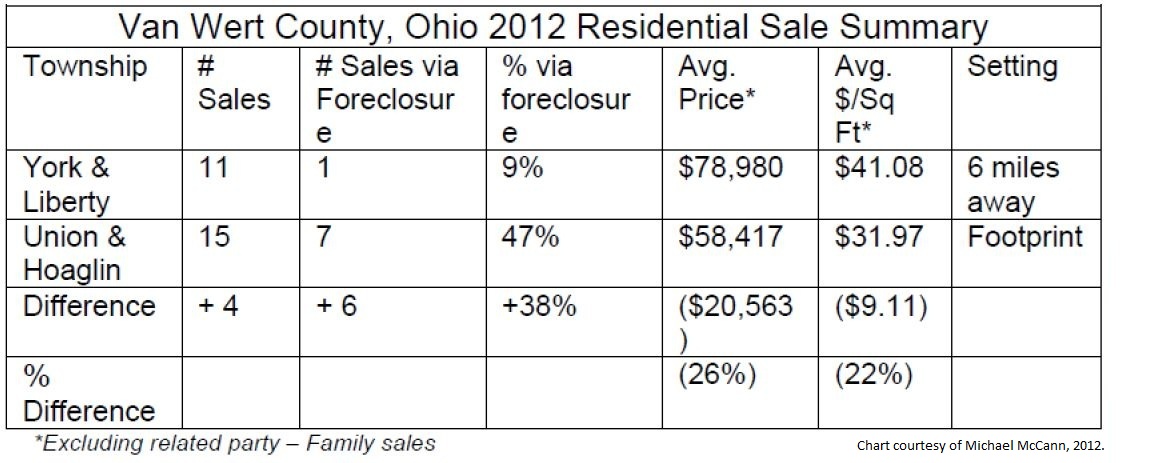
(An engineer’s rendering of a proposed turbine in Searchlight)
SEARCHLIGHT — Ellen Ross, a Las Vegas-based real estate agent, bought her 17-acre property in Searchlight nine years ago as a reprieve from Vegas noise and for the property’s long vistas of Joshua trees and the Newberry Mountains.
Her days of enjoying that uncluttered natural view became numbered, however, on March 13. That’s when she learned she’ll be getting new neighbors: a dozen 428-feet-tall wind turbines — each taller than the length of an American football field.
U.S. Secretary of the Interior Ken Salazar approved the turbines. They’ll not only ruin her view, says Ross, but, more importantly, they’ll significantly reduce the value of her property.
“I’ve been in the real estate industry for over 30 years,” said Ross. “Who is going to want to buy property next to these giant turbines?”
Michele Shafe, the Clark County Assessor, told Nevada Journal she couldn’t speculate on how much the wind turbines would affect Searchlight property values, because wind turbines “are relatively new” to Clark County.
However, recent studies and testimony by real estate appraisers from around the world indicate that properties within two to three miles of wind turbines have seen their values decline from 25 to 60 percent — with the decreased value being “tantamount to an inverse condemnation, or regulatory taking of private property rights.”
One recent case study was conducted by Ben Lansink, a real estate appraiser based in Ontario, Canada. His study focused on the 133-turbine Melanchthon Wind Facility, 67 miles from Toronto — nearly the same distance as Searchlight is to Las Vegas.
Lansink reported that homes within two miles of the wind turbines sold for an average of 38 percent less than homes further away from the turbines. Some homes within the turbines’ two-mile “footprint” sold for as little as 58.5 percent less.
“Certainly not every home within two miles of a turbine is affected,” said Lansink. “But as we learn more and more about turbines, there’s a growing understanding that turbines do cause diminution of property. The question becomes: How much?”
The Searchlight Wind Energy, LLC Project — owned and operated by North Carolina-based Duke Energy — will consist of 87 turbines sitting on 9,300 acres of federal land. The project originally called for 161 turbines, according to Greg Helseth, a renewable-energy project manager at the Southern Nevada Bureau of Land Management, but the amount was reduced due to “the changing market of large-scale wind projects.”
“Five years ago, there was a larger appetite for this type of project,” said Helseth. “The applicant [Duke Energy] pared it down with the changing demand.”
All 87 of the turbines are now planned for the east side of Searchlight. The original plans called for turbines to be located on both sides of US 95, the main highway that divides the town.
“Lots of [Searchlight residents] don’t want this project,” said Judy Bundorf, whose home will be 1.2 miles from the turbines.
“People live here, retire here, vacation here because of the natural beauty. They don’t want to wake up every day and see 400-foot tall turbines sticking out of the desert.”
Despite the reduction in the number of proposed turbines, it only takes one turbine to create a “bona-fide nuisance,” according to Michael McCann, a Chicago-based real estate appraiser.
“Residential properties are more sensitive to undesirable locations,” said McCann. “One mile may seem like a long distance away, but it doesn’t take much for the property to experience a diminution effect.”
McCann has evaluated or consulted on more than 20 wind projects in 12 states, and has published his own case studies showing turbines’ impacts on property value. In a 2012 study he conducted on Van Wert County, Ohio, McCann says he discovered that homes within the turbine’s two-to-three mile “footprint” sold for 26 percent less than homes six miles away from the turbines.
McCann’s most recent case study, a March 2013 evaluation of a proposed wind farm in Tipton County, Ind., concluded that homes nearest to the proposed turbines could see at least a 25 percent loss in value, and that the 1,250-foot turbine-to-property setback proposed by the turbine company was inadequate.
For its Searchlight Final Environmental Impact Statement (FEIS) project, the BLM cited 10 different studies of wind projects’ impact on property values. The agency concluded that “no clear inference can be drawn from these studies,” and that the varying research methodologies suggest that “there is no negative relationship between wind energy developments and property values.”
“We [BLM] listened to the public comment and included all of our recommendations in the final statement,” said Helseth.
The studies BLM referenced ranged from a 1996 study conducted by The Institute of Local Government Studies in Copenhagen, Denmark, to a 2009 study by the Department of Energy-funded Lawrence Berkeley National Laboratory in Berkeley, Calif.
While most of the studies were conducted by academics or prepared on behalf of wind companies, McCann and Lansink are each 30-year veterans of the appraisal industry.
“I wasn’t paid. I didn’t do [the study] for the wind industry or for the people affected by them,” Lansink said.
McCann’s Tipton County study lists four categories of “nuisance” issues related to turbines: Noise, Visual, Safety, and Essential Character — meaning the turbine changes the nature of the landscape.
All four issues could affect Searchlight residents, but the two issues residents are most concerned about are the noise and visual, says Bundorf. Representatives from the BLM and Duke Energy told residents at a public meeting during the planning phase that the turbines wouldn’t sound any louder than a “refrigerator humming.”
However, a 2010 assessment of wind turbine noise published by Rand Acoustic, a Maine-based acoustic consulting company that specializes in environmental noise control, concluded that: “Wind turbines larger than one megawatt of rated power have become an unexpected surprise for many nearby residents by being much louder than expected.”
Said the assessment: “Wind turbines are not synchronized, and so thumps may arrive together or separately, creating an unpredictable or chaotic acoustic pattern. The sounds of large industrial wind turbines have been documented as clearly audible for miles. They are intrusive sounds that are uncharacteristic of a natural soundscape.”
On YouTube, homeowners around the country have sought to share their experience of nearby power windmills. An example is the report of this Wisconsin homeowner, who says he lives only 1,600 feet from a turbine.
Several appraisers, including McCann, compare living next to a wind turbine to living next to an airport.
“Imagine living very close to a large airport, and a plane passing between you and the sun, and the giant shadow it casts on you for a moment,” McCann said. “Now, imagine that this happened every sunny morning, 30 times per minute, for an hour and a half, and then the next day, and next day.”
The turbines will line the desert landscape stretching toward Cottonwood Cove near the Lake Mead Recreational Area. Bundorf’s brother-in-law, a retired engineer, used the BLM and Duke Energy proposals to create a photo rendering of what the turbines will look like from Ross’ neighbor’s property. Ross’ and her neighbor’s properties are just over 1,000 feet away from the proposed turbines. The photo graphic suggests the view they formerly enjoyed will be drastically changed.
(Image courtesy of Wayne Bundorf)
“This is pristine desert property,” Ross said. “Most of us bought property out here for the peace and quiet and unobstructed views. This [wind farm] changes everything about our [property] value.”
McCann’s study also raises the issues of the safety of crop-dusting pilots flying low over farms where wind turbines operate, and of the “Essential Character” of areas changing because of the “industrial overlay” of the turbine machinery.
Many Searchlight residents, including Sandy Walters, chairwoman of the Searchlight Town Advisory Board, believe animal safety is a concern, too, especially in the wake of the Spring Valley Wind Farm in White Pine County reporting the death of its first golden eagle.
“[Dead birds are] not something we want to be known for,” said Walters. “Tourists drive here from other states to see the scenery, and they’re driving to get away from things like wind farms.”
As part of its FEIS, BLM provided a Bird and Bat Conservation Strategy report that concluded no bald nor golden eagles were within the project’s area. The federal land agency has also provided a similar report for the White Pine County wind farm, citing national wind experts who “estimated that 2.3 avian fatalities per turbine per year (3.1 per megawatt per year) occur in the United States.”
A spokeswoman for the White Pine County assessor’s office told Nevada Journal that White Pine’s Spring Valley Wind farm hadn’t been operational long enough to determine its impact on property values.
Diane Kendall, a member of the Searchlight Advisory Board and a real estate agent, supports the wind project and thinks if it was able to pass all of the BLM’s regulations, then it should be good for the town.
“Everything a human does has impact on the land,” said Kendall. “BLM has some of the strictest regulations around, so if it passed them, then I think we should go for it.”
Helseth told Nevada Journal the project is still at least two to three years away from officially breaking ground. For residents like Ross, that means they have a few years left to enjoy their view.
“The good doesn’t outweigh the bad,” said Ross.
“If I brought someone out here to look at property with a view of the mountains or a property with a view of wind turbines, which one do you think they’ll buy?”
Kyle Gillis is a reporter for Nevada Journal, a publication of the Nevada Policy Research Institute. For more in-depth reporting, visit https://nevadajournal.com/ and http://npri.org/.


